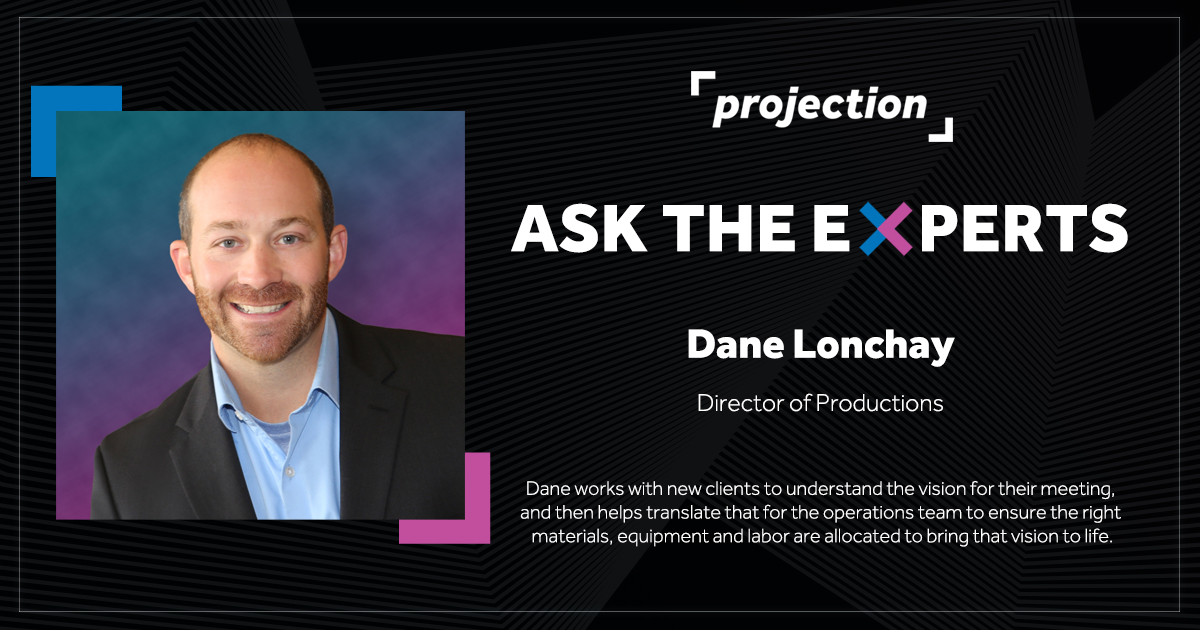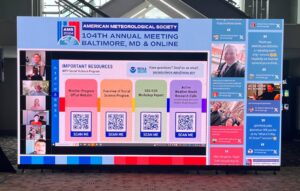
Since the pace of change in the meetings and events industry seems to be stuck on overdrive, we wanted to spend some time with experts in the field who can share what they are seeing, trends coming up (and going away) and how attendees are reacting to all of it.
This is our first post in our “Ask the Experts” series. Over the next several months, we will be talking to experts who hold different roles across the industry and sharing their insights here.
Our first expert is Dane Lonchay, Director of Productions at Projection. In his role, Dane works with new/existing clients to understand the vision for their meeting, and then helps translate that for the sales & operations team to ensure the right materials, equipment and labor are allocated to bring that vision to life.
Q: What are a few trends you’re seeing in association events today?

Projection’s director of creative services, Joe Faulder, recently wrote about why your GS should serve as the first step to a more strategic meeting.
A: We are noticing larger general sessions (GS) compared to previous years. Driving that trend is the comeback of large-scale events post COVID and the need to create experiences for attendees throughout the entire meeting. We see associations taking advantage of the fact that the GS can serve as THE “moment” that hooks attendees, and therefore going bigger so attendees walk away feeling excited about the rest of the event (and, ideally, future events as well).
Interestingly, virtual has not disappeared completely, and has remained a part of many of the general sessions we work on. Attendees are excited to return to in-person events, and have come to expect an option to consume inclusive and engaging content virtually. In terms of executing virtual options, we are seeing a mix: sometimes, presenters join the plenary remotely or a smaller audience is watching a virtual broadcast. Given the number of attendees, expectations for hybrid content and changing speaker preferences, I do not expect this trend to slow down or go away.
Q: What is driving those trends?
A: We are seeing more people traveling and attending events again (post pandemic), and that they expect to be fully engaged by and immersed in the experience. They are looking for opportunities to interact with others, so event planners need to continue to find ways to develop more inclusive and engaging events.

Social Media LED Wall at the American Meteorological Society’s 104th Annual Meeting
Q: What are some things associations can do to achieve better results?
A: Interactive breaks are one way to keep audience member engaged and not overwhelmed by too much content. Other options include: having areas that are Live or Video on Demand; hosting special guest talks (e.g., sponsors interviewing attendees) or offering live performances, which are always a great way to split up the back-to-back content. Not only do these keep people highly engaged, but can also help promote the overall conference and reach new potential attendees.
If your event has a virtual component, it’s important to have a location where social wall can be seen (e.g., on a video wall); doing so gives remote attendees a voice within the conference.
Q: What are the factors/components that go into making a successful GS?
A: General sessions will continue to grow. As a result, keeping all attendees engaged – from the front of the room to the back – is crucial. Unfortunately, I see events where only the front of the audience is being engaged. The GS team can address this by ensuring video, lighting and sound are present in the back half of the room. It’s all about inclusivity. Designing inclusive events – and choosing inclusive environments/properties – is critical to captivating your whole audience.
When it comes to the GS, you want attendees to be able to recall how it made them feel throughout the entire event. When designing a large session, you want to not only ensure your key message(s) is being received and vision is being conveyed, but that it creates a reason for members and attendees to come back next year (and the year after). The scenery can play a large role. Working with a designer on what you want your event to “feel” like is one of the key ways to achieve this. From the physical set design to the colors you chosen, you want to create a complete design for the meeting from start to finish.
Q: How should planners/associations think more strategically about their event?
A: It’s all about planning and having the right people involved in those conversations. At Projection, we recommend identifying the people who should have a seat at the table and starting to have initial conversations about 9 to 12 months before next year’s meeting. From there, it’s critical to be organized and working towards a shared timeline to ensure the proper items are being completed on time. A best practice is to check off small tasks over time; doing so helps to keep the overall process less stressful and easier to manage.
For more, check out our blog post: The Importance of Thinking Strategically About Your Meeting – and How to Get Started
Q: What are 3 things you want every association/planner to bring to the table [when working with you for their event]?
1: Go into the design process with a clear view of the message/feel of the event, who your target audience is and what you want attendees to walk away with, especially when it comes to future events. This will help the process of designing an event that aligns with your brand and your team’s – and members’ – expectations.
2: A global plan and timeline of when deliverables will be completed. Your vendor partners should also have timelines of their own to incorporate. And, since we know things come up that impact that timeline, having a back-up plan if those materials are not sent across on time. These important assets will limit the onsite scramble.
3: A predetermined vision for the event. With that in place, our designers can help make it come to life.
Q: What are the tech tools you couldn’t live without when planning an event?
A: My list of tools is not fancy, but they are critical for a well-executed meeting.
- A clear run of show (ROS), with allocations for the whole crew
- Presentation file storage and content management system
- Global production schedule
- Video Meetings – IE Teams/Zoom
- Timeline that begins with the first production call and ends with the post-show debrief
More from “Ask the Experts”
[Part Two] Talking Creative Event Assets and Audience Engagement with Kevin Wilson
[Part Three] Custom Technology Solutions for Events and Why They Matter with Simon Tuck
